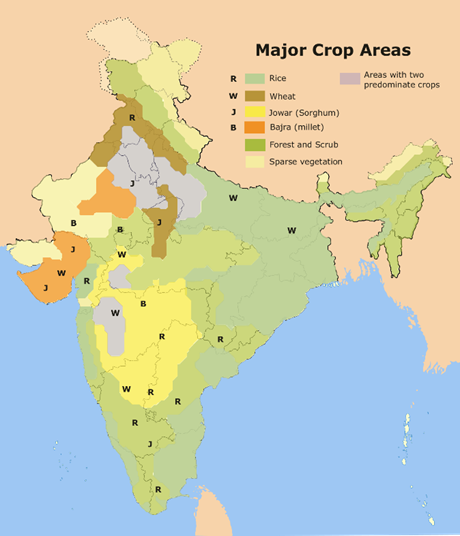- Courses
- GS Full Course 1 Year
- GS Full Course 2 Year
- GS Full Course 3 Year
- GS Full Course Till Selection
- MEP (Mains Enrichment Programme) Data, Facts
- Essay Target – 150+ Marks
- Online Program
- GS Recorded Course
- NCERT- First Ladder
- Polity
- Geography
- Economy
- Ancient, Medieval and Art & Culture AMAC
- Modern India, Post Independence & World History
- Environment
- Governance
- Science & Technology
- International Relations and Internal Security
- Disaster Management
- Ethics
- Current Affairs
- Indian Society and Social Issue
- CSAT
- 5 LAYERED ARJUNA Mentorship
- Public Administration Optional
- ABOUT US
- OUR TOPPERS
- TEST SERIES
- FREE STUDY MATERIAL
- VIDEOS
- CONTACT US
Cropping pattern in India
Cropping pattern in India

Cropping pattern in India
About
- Cropping pattern refers to the practice of growing different crops in a particular area over a period of time. It is a strategy that farmers use to optimize the use of their land and resources to increase productivity and income.
- The cropping pattern in a particular area is influenced by various factors such as climate, soil type, availability of water, market demand, and government policies.
- Farmers typically choose crops based on their profitability, suitability to the local environment, and market demand. In some areas, farmers follow a specific sequence of crops, such as growing a legume crop after a cereal crop to improve soil fertility.
- Cropping patterns may also include multiple crops grown on the same plot of land during the same season, known as intercropping, or growing crops in alternate seasons, known as crop rotation. The choice of cropping pattern has a significant impact on the soil health, water availability, and the overall sustainability of agricultural practices in a region.
Types Of Cropping Patterns
There are various types of cropping patterns that farmers use to optimize the use of their land and resources. Some of the most common types:
- Monocropping: This involves growing only one type of crop on a particular piece of land in a given season. Monocropping is common in areas where the soil and climate conditions are well-suited to a specific crop.
- Intercropping: This involves growing two or more crops simultaneously on the same plot of land. Intercropping can help farmers increase the productivity of their land, as different crops can complement each other in terms of nutrient requirements, water usage, and pest management.
- Crop rotation: This involves growing different crops in a particular area in a specific sequence over a period of time. Crop rotation can help maintain soil health and fertility by reducing soil-borne diseases, pests, and weeds. It also helps to diversify the farmer's income and spread the risk.
- Relay cropping: This involves growing two or more crops in the same field during the same growing season, with one crop being sown after the other has already germinated. Relay cropping can help farmers to optimize the use of their land and water resources.
- Mixed cropping: This involves growing two or more crops simultaneously on the same plot of land, without any specific sequence. Mixed cropping can help to reduce risk and increase productivity, as different crops can complement each other in terms of resource utilization.
- Multiple cropping: This involves growing two or more crops in the same field during the same growing season. Multiple cropping can help to increase the productivity of the land, as it enables farmers to use the same resources multiple times in a given year. However, it requires careful planning and management of resources.

Factors Affecting Cropping Pattern in India
- Climatic conditions: India has a diverse climate, with different regions experiencing varying temperatures, rainfall patterns, and weather events. These climatic conditions determine the choice of crops that can be grown in a particular area.
- Soil type and fertility: The fertility of the soil, its pH level, texture, and moisture holding capacity, determine the type of crops that can be grown in a particular area. Farmers must choose crops that are well-suited to the soil type to optimize yields.
- Availability of water: Water availability is a critical factor in determining the cropping pattern in India, especially in areas that are prone to droughts. Farmers must choose crops that are drought-resistant or can be irrigated with available water resources.
- Market demand: Market demand for crops is a critical factor that influences the cropping pattern in India. Farmers often choose crops that have high market demand and offer good returns on investment.
- Government policies: Government policies such as subsidies, loan schemes, and minimum support prices can influence the choice of crops that farmers grow in a particular area.
- Technology and infrastructure: The availability of technology and infrastructure such as irrigation facilities, storage facilities, and transportation networks can also influence the choice of crops that farmers grow in a particular area.
- Land tenure and ownership: Land tenure and ownership patterns can affect the cropping pattern in India. Small farmers may have limited access to resources and may have to grow crops that offer immediate returns on investment. Large landowners, on the other hand, may be able to invest in long-term cropping patterns that offer higher returns over time.
Changing Cropping Pattern in India
There are several emerging trends in India's cropping pattern that reflect changing market demand, technological advancements, and environmental considerations.
- Increasing Organic farming: With increasing awareness about the harmful effects of chemical fertilizers and pesticides, there is a growing trend towards organic farming in India. Farmers are adopting practices such as crop rotation, intercropping, and use of bio-fertilizers to improve soil health and reduce chemical inputs. For example, the state of Sikkim has become India's first fully organic state, and many farmers across the country are following suit.
- Demand for High-value crops: There is a growing demand for high-value crops such as fruits, vegetables, and spices in both domestic and international markets. Farmers are shifting towards these crops to earn higher incomes. For example, the state of Himachal Pradesh has shifted from traditional crops such as wheat and rice to high-value crops such as apples, cherries, and kiwis.
- Precision farming: With the help of advanced technologies such as sensors, drones, and GPS, farmers are adopting precision farming practices to optimize crop yields and reduce wastage. For example, farmers in Gujarat are using drones to monitor crop growth and identify areas that require irrigation or fertilization.
- Sustainable cropping patterns: With concerns over environmental degradation and climate change, there is a growing trend towards sustainable cropping patterns such as agroforestry, conservation agriculture, and zero-till farming. For example, farmers in the state of Madhya Pradesh are adopting agroforestry practices, where they grow crops such as wheat and soybeans along with trees such as neem and moringa.
- Contract farming: With the help of technology and better market linkages, contract farming is becoming a popular option for small farmers to secure stable prices and markets for their crops. For example, PepsiCo has launched a contract farming program for potato farmers in Gujarat, where farmers grow specific potato varieties for the company's chips and snacks.
Issues With Current Cropping Pattern
- Old techniques: Although India's agricultural practices are now self-sufficient, production continues to be resource-intensive, cereal-centric, and regionally biased. Sustainability issues have arisen as a result of these flaws.
- Methods that don't last: Slow agricultural growth is a concern for policymakers because the current agricultural practices are neither economically nor environmentally sustainable, and over half of India's population relies on rural employment for a living.
- Food crop dominance of cereals: Wheat and rice are the most common cereals among the many food crops. Cement has been grown on 82% of the land previously used for food crops. This is because better seeds are available, prices are lower, and production risks are lower.
- Decline in millets cultivation: decline in Jwar, Bajra, maize, millets, and barley, among other coarse cereals are referred to as inferior or coarse cereals. From 48% in 1950-51 to around 29% in 2001, the ratio of these crops to the total area under cereal crops has significantly decreased. This is because irrigation facilities have spread, inputs have improved, and people's consumption patterns have changed.
- Decreasing significance of Kharif crops In India, there are primarily three cropping seasons: Kharif, Rabi, and Zaid. The Rabi season coincides with the winter, while the Kharif season coincides with the rainy season. The Zaid season refers to the brief time period between Rabi crop harvest and Kharif crop sowing.
- Social issues: The increased feminization of agriculture, primarily as a result of an increase in the number of households headed by women, an increase in men's migration from rural to urban areas, and an increase in the production of cash crops that require a lot of labor, has brought about more significant social changes in agriculture in recent years.
Consequences due to current cropping pattern
- Effects of Increasing Fertilizer and Pesticide Use in Current Cropping Patterns: Inorganic fertilizers and pesticides are being used more and more to grow crops, which has two main drawbacks: One reason is that the toxins in fruits and vegetables are affecting our health to such an extent that our bodies are unable to handle them, resulting in frequent illness. Second, the pests develop a tolerance to the pesticides, making them gradually ineffective.
- Utilization of High Yielding and Hybrid Varieties: In the past, we grew crops with our own indigenous seeds, which were more nutritious. Following the beginning of the green revolution, hybrid seeds are now being utilized. They aren't very filling, and this awareness has made organic farming more important. However, organic farming isn't done on a large scale, so it doesn't have a big effect on production overall. This necessitates the creation of a new system that combines traditional and contemporary scientific methods to maximize benefits and minimize drawbacks.
- Demand for Water to Grow: Ore water is required in order to use the new production methods. In fact, the agricultural sector uses 10% of our water, and intensive cropping would increase this demand. Our ground water resources are depleted as a result. The government must undertake an increasing number of irrigation projects, which have negative effects on the environment and use agricultural land for non-agricultural purposes.
- The loss of forest land: In order to maintain ecological equilibrium, a minimum amount of forest land—33 percent—must be maintained. The forest cover decreases when cropping intensity is increased. Through methods of afforestation and the upkeep of the existing reserves, we have attempted to maintain a reasonable forest cover. This ecological equilibrium has been disturbed in many places due to an increase in agricultural activities, which must be addressed.
Sikkim case study: India’s first organic farming state
- All of Sikkim's farmland is certified organic, making it the world's first organic state.
- The state's policy approach has been transformative for its citizens and extends beyond organic production.
- It focuses primarily on cultural, health, education, rural development, sustainable tourism, and socioeconomic factors like consumption and market expansion.
- The state's organic farming policy has resulted in the phased elimination of chemical fertilizers and pesticides and the complete prohibition of their sale and use in the state.
- More than 66,000 farming families in the state have benefited from the transition.
- The state's transition to a 100 percent organic diet has also helped the state's tourism industry a lot. Between 2014 and 2017, the number of tourists increased by more than 50 percent.
- By successfully upscale agroecology, Sikkim has set a great example for other Indian states and nations worldwide.
- Sikkim won the Future Policy Gold Award (Gold Prize) from the UN Food and Agriculture Organization (FAO) for becoming the first state in the world to use only organic farming methods.
Conclusion
There has been a widening gap between the incomes of workers in the agricultural and non-agricultural sectors in India as a result of the agriculture sector's slowing growth in comparison to the overall economy.
Despite the fact that Indian farmers are extremely conservative and poor, appropriate adjustments to their economic motivations can alter their cropping patterns.
It is necessary to move toward sustainable agriculture. The environmental cost should also be taken into account in the policies. Planning should take into account the need for food security for the next generation.




